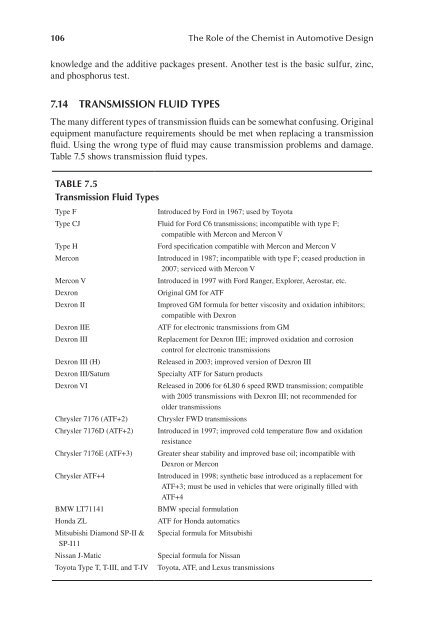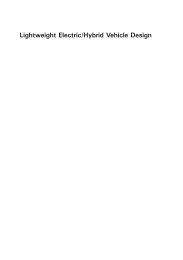THE ROLE OF THE
THE ROLE OF THE
THE ROLE OF THE
Create successful ePaper yourself
Turn your PDF publications into a flip-book with our unique Google optimized e-Paper software.
106 The Role of the Chemist in Automotive Design<br />
knowledge and the additive packages present. Another test is the basic sulfur, zinc,<br />
and phosphorus test.<br />
7.14 transmIssIon FluId tyPes<br />
The many different types of transmission fluids can be somewhat confusing. Original<br />
equipment manufacture requirements should be met when replacing a transmission<br />
fluid. Using the wrong type of fluid may cause transmission problems and damage.<br />
Table 7.5 shows transmission fluid types.<br />
table 7.5<br />
transmission Fluid types<br />
Type F Introduced by Ford in 1967; used by Toyota<br />
Type CJ Fluid for Ford C6 transmissions; incompatible with type F;<br />
compatible with Mercon and Mercon V<br />
Type H Ford specification compatible with Mercon and Mercon V<br />
Mercon Introduced in 1987; incompatible with type F; ceased production in<br />
2007; serviced with Mercon V<br />
Mercon V Introduced in 1997 with Ford Ranger, Explorer, Aerostar, etc.<br />
Dexron Original GM for ATF<br />
Dexron II Improved GM formula for better viscosity and oxidation inhibitors;<br />
compatible with Dexron<br />
Dexron IIE ATF for electronic transmissions from GM<br />
Dexron III Replacement for Dexron IIE; improved oxidation and corrosion<br />
control for electronic transmissions<br />
Dexron III (H) Released in 2003; improved version of Dexron III<br />
Dexron III/Saturn Specialty ATF for Saturn products<br />
Dexron VI Released in 2006 for 6L80 6 speed RWD transmission; compatible<br />
with 2005 transmissions with Dexron III; not recommended for<br />
older transmissions<br />
Chrysler 7176 (ATF+2) Chrysler FWD transmissions<br />
Chrysler 7176D (ATF+2) Introduced in 1997; improved cold temperature flow and oxidation<br />
resistance<br />
Chrysler 7176E (ATF+3) Greater shear stability and improved base oil; incompatible with<br />
Dexron or Mercon<br />
Chrysler ATF+4 Introduced in 1998; synthetic base introduced as a replacement for<br />
ATF+3; must be used in vehicles that were originally filled with<br />
ATF+4<br />
BMW LT71141 BMW special formulation<br />
Honda ZL ATF for Honda automatics<br />
Mitsubishi Diamond SP-II & Special formula for Mitsubishi<br />
SP-I11<br />
Nissan J-Matic Special formula for Nissan<br />
Toyota Type T, T-III, and T-IV Toyota, ATF, and Lexus transmissions







